Nervous horses can be a challenge to approach, especially for those new to horse handling.
As an equestrian, I’ve learned through personal experience that staying calm and confident when approaching a nervous horse is crucial.
My first encounter with a genuinely nervous horse was my first horse an old off-the-track Thoroughbred broodmare, who had been abused and neglected.
Gaining her trust took patience and understanding, but this journey taught me invaluable lessons about the impact of my body language on the horse and the importance of speaking calmly to avoid tensing up.
Approaching a nervous horse can be challenging, but with the right mindset and approach, you can help both you and the horse feel more at ease.
Horses prone to anxiety need a rider or handler who isn’t intimidated by their size, can provide clear signals, and knows how to cope with their own nerves.
Easing equine anxiety involves teaching the horse how to cope with anxiety and seek out calmness..
In this article, we’ll explore the key steps and techniques for approaching a nervous horse confidently, safely, and effectively.
| Key Points For Approaching A Nervous Horse |
|---|
| 1. Assess the Situation |
| 2. Create a Calm Environment |
| 3. Gain Trust through Touch |
| 4. Establish Control with Body Language |
| 5. Build Confidence through Repetition |
As you learn to confidently approach nervous horses, keep in mind that patience, understanding, and careful observation of the animal’s body language are essential.
By staying calm and confident, you create a sense of safety for both yourself and the animal.
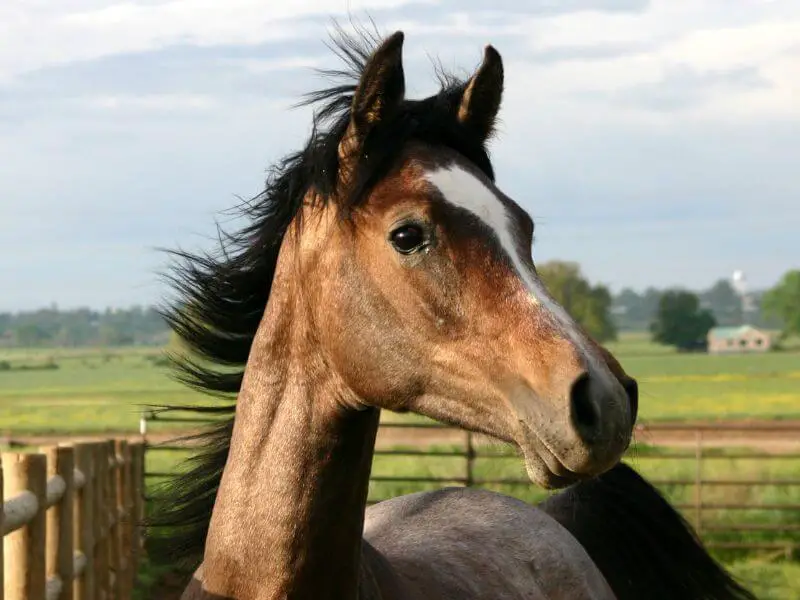
APPROACHING NERVOUS HORSES WITH CONFIDENCE
When approaching a nervous horse, confidence is key. You need to display a sense of calmness and control when interacting with the animal.
If you approach a horse in an anxious or nervous state, the energy you emit can cause the horse to feel uneasy and more likely to react negatively.
To approach a nervous horse confidently, it’s essential to remember that horses are flight animals.
They instinctively want to run away from danger or anything they perceive as threatening.
Therefore, your approach should be slow and steady, giving the animal time to assess your presence before making any sudden movements.
Speaking softly in soothing tones can also help put the horse at ease.
It’s important to focus on the positives and gather as much information about the horse in advance.
For example, knowing a horse’s history, previous experiences, and triggers can be incredibly helpful when approaching them.
Having some tasty treats handy is another great way to build trust with a nervous horse. This makes it easier for them to associate positive experiences with human interaction.
Just make sure you don’t rely on treats as a lure and use it as a reward for when the horse does whatever positive behavior.
By approaching nervous horses calmly and confidently while avoiding sudden movements or loud noises, you’ll be well on your way to gaining their trust.
Remember that building trust takes time, but with patience and persistence, it is possible.
To sum up approaching a nervous horse confidently:
- Be calm and collected, avoiding anxiety or nervousness.
- Approach slowly and steadily, giving the horse time to assess your presence.
- Speak softly in soothing tones to help the horse feel at ease.
- Gather as much information about the horse as possible beforehand.
- Have treats handy to create positive associations with human interaction.
- Avoid sudden movements or loud noises.
Keep these tips in mind, and you’ll be well-equipped to approach and build trust with nervous horses effectively and safely.
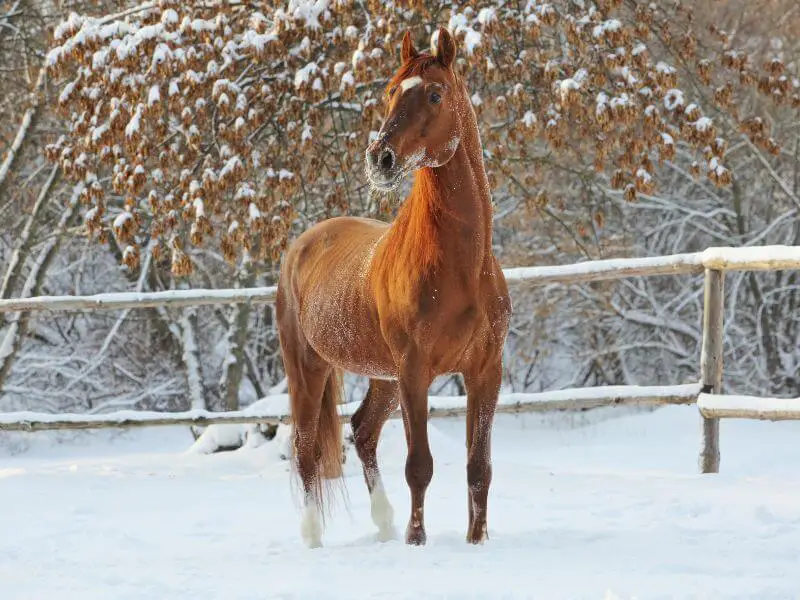
ASSESSING THE SITUATION
It is critical to thoroughly assess the circumstances before approaching a scared horse.
Let’s discuss the significance of studying the horse’s body language, identifying probable triggers for anxious behavior, and comprehending the distinct circumstances that may contribute to a horse’s nervousness.
Gaining insight into the horse’s state of mind and environment will enable you to approach them with confidence and care, resulting in a more positive encounter.
Observing The Horse’s Body Language
Before approaching a nervous horse, it’s essential to take the time to observe its body language. A horse’s body language gives you insight into how it is feeling at that moment.
Some signs of nervous behavior include:
- Pacing, trying to flee
- Wide open eyes see the whites of the eye
- Flared nostrils
- Spooking
- Tail swishing a lot or clamped and tense
- Ears back, locked forward, or moving around a lot
- Tense body
- Lean away from you
- Head held high
- Nervous pooping
These are all indications that the horse may be feeling uneasy or uncomfortable.
My experience with a sensitive Paint horse taught me the importance of understanding a horse’s body language. He would position his body for flight and keep a watchful eye on me, clearly showing his wariness.
To approach him confidently, I needed to be mindful of his signals and respond accordingly.
I observed his rapidly flicking ears and wide, darting eyes, which indicated his heightened state of alertness and nervousness.
By reading his total body language, I could better gauge his state of mind and adapt my approach.
Horses communicate extensively through body language, and they immediately pick up on emotions and notice the most subtle movements.
Observing a horse’s body is crucial when approaching a nervous horse. A horse’s body language can indicate if they are anxious, in pain, or frightened.
For example, a horse in acute stress may display forward-pointing ears, wide-open eyes, widened nostrils, and tense muscles above the eye, creating upside-down, V-shaped wrinkles.
Nervous horses also tend to poop as a anxious response.
It’s important to “read” the horse’s total body language together to get a full understanding of their state of mind.
By paying close attention to these signals, you’ll be better equipped to approach and interact with nervous horses, providing them with the reassurance and guidance they need to feel more at ease in your presence.
Remember, the key to approaching a nervous horse confidently is being mindful of their body language and responding appropriately.
With practice and patience, you can learn to read and understand these signals, creating a better experience and space for your horse to start to trust you.
Identifying Potential Triggers For Nervous Behavior
Once you’ve observed what the horse is communicating to you with their body and identified some signs of nervous behavior, it’s time to consider what might be causing these reactions.
Common triggers for nervousness in horses include:
- loud noises (such as thunder)
- unfamiliar objects or people
- tight spaces
- sudden movements
Consider your surroundings when approaching a nervous horse – if there is something out of place that could cause alarm, make sure to stay aware of how the animal is reacting to it.
Some horses, like the Paint I mentioned before, have been handled roughly by previous owners and may be more sensitive to certain actions.
By identifying these triggers, we can adjust our approach and avoid causing additional stress.
For example, if loud noises seem to be causing fear in your horse, try playing music quietly nearby while working with them so they can get used to hearing different sounds without becoming frightened.
Horses can also become anxious in certain situations, such as new environments, riding with strange horses, or when they have not had much riding lately.
Changes in herd dynamics or pain can also cause anxiety in horses.
It’s important to be aware of these triggers and take steps to alleviate the horse’s fear before it panics.
For instance, when introducing a horse to a new environment, you might spend some time allowing them to explore the area before asking them to perform any tasks.
In my experience, understanding the potential triggers for a nervous horse is essential for a successful interaction.
Being mindful of these triggers and modifying your environment accordingly can help you approach a nervous horse more confidently and safely.
By taking the time to learn about your horse’s unique needs and sensitivities, you can create a more positive and trusting relationship, ultimately helping both you and your equine companion feel more at ease.
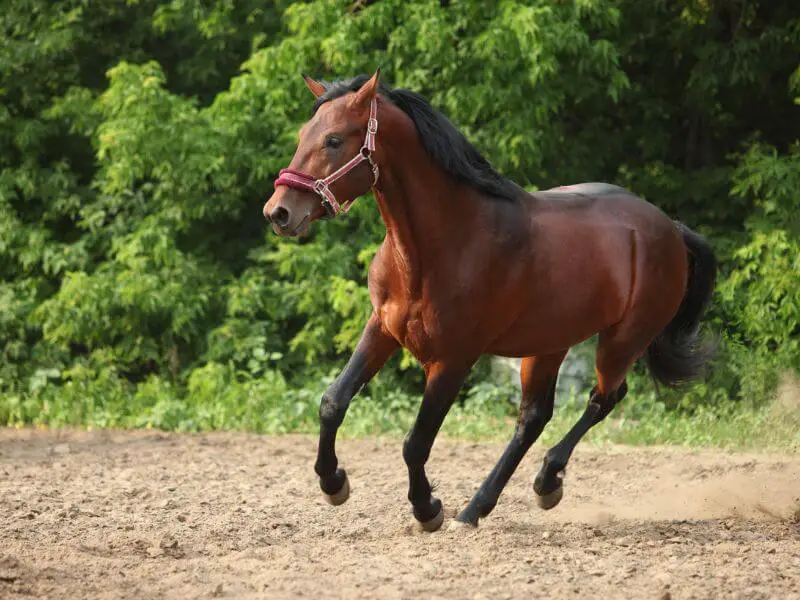
CREATING A CALM ENVIRONMENT For The Nervous Horse
Setting the stage for a positive interaction is crucial, and by taking a few key steps, we can help both the horse and ourselves feel more relaxed and at ease.
We’ll discuss approaching the horse slowly and steadily, speaking in a soothing tone, and avoiding sudden movements or loud noises.
These techniques will help ensure a smoother and safer experience when working with a nervous horse.
Approaching The Horse Slowly And Steadily
When approaching a nervous horse, it’s essential to approach slowly and steadily.
Any sudden movements can startle the horse, causing it to become anxious or even dangerous.
Moving too quickly towards the horse can make it feel threatened and defensive.
A slow and steady approach will allow the horse to assess you and decide whether you are a friend or a foe. Remember, horses are prey animals, so any perceived threat will trigger their instinct for self-preservation.
Start by standing several feet away from the horse and observe its reaction to your presence.
If the horse seems nervous or agitated, step back slightly until it calms down. When approaching again, take small steps with gentle movements in your body language.
It’s important not to stare at the horse or make direct eye contact as this can be intimidating for them.
In my own experience with my first horse, Kyia, I found that walking sideways towards her, instead of directly, made her feel less threatened.
This technique eventually helped her become more accepting of my presence, and it’s an approach that can be helpful for others working with anxious horses.
A anxious horse can be calmed by approaching it gently and gradually. Be patient and take your time gaining the horse’s trust. The horse will feel more at ease and have less stress if you approach it gently and gradually.
Speaking In A Soothing Tone
Horses have exceptional hearing abilities, far superior to those of humans.
Softly spoken words and a calm tone can be reassuring to them, as they associate these sounds with their handler’s intentions.
As I’ve learned from my own experiences, talking to a horse calmly can prevent you from holding your breath and tensing up, which could inadvertently make the horse more nervous.
When approaching a scared horse, it can be useful to speak in a soothing tone.
Because horses are so sensitive to human voices, lowering your voice a few octaves and speaking slowly almost drawn out, can help relax the animal.
Avoiding Sudden Movements Or Loud Noises
Being mindful of your movements and the surrounding environment is key to creating a calming atmosphere for the horse.
Sudden movements or loud noises can trigger flight responses in horses, which means they may run away suddenly without warning if startled by something unexpected or too intense.
Keeping your body movement fluid and slow also helps keep things calm, as rapid movement is often seen as predatory behavior by horses, triggering their defense mechanisms.
In my experience, try to keep sharp noises to a minimum; avoid clapping, banging, or any other sudden sounds.
Unless you are specifically working with a horse to desensitize to loud noises and you know what you are doing.
But in this circumstance of approaching a nervous horse, it is not something you want to do.
Avoid making any sudden movements or loud noises while approaching an anxious horse.
Because horses are easily frightened by unexpected motion, noise, or novelty, it is important to keep your wits about you and plan ahead.
However, you don’t want to be so quiet or slow in your movement that the horse thinks you are a predator stalking them.
Instead, you should work on convincing the horse that it is safe in your presence.
Reducing the horse’s nervousness and gaining its trust can be accomplished by minimizing unexpected movements and loud noises and by building confidence in the horse.
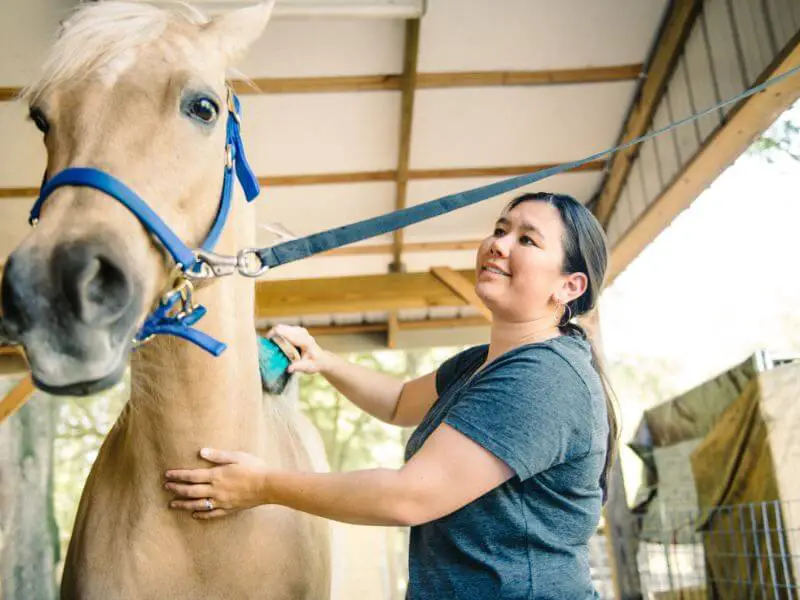
GAINING TRUST THROUGH TOUCH
Gaining trust through touch is a crucial aspect of building a strong bond with a nervous horse. They need to know you are not going to hurt them that you are in fact friendly.
In this section, we will explore how to offer your hand for the horse to smell, pet the horse gently on its neck or shoulder, and allow the horse to approach you on its own terms.
Offering Your Hand For The Horse To Smell
One way to start to gain a horse’s trust and introduce yourself is by offering your hand for the horse to smell.
Horses have a really good sense of smell and use it to recognize individuals, so allowing them to familiarize themselves with your scent can ease their nerves.
Hold your hand out with your palm down and your hand cupped like a horses muzzle.
Avoid touching the horse before it has had a chance to sniff your hand.
From my personal experience, when I approached a wild Chincoteague pony at a farm in Rhode Island, I found that offering my hand for her to sniff and eventually stroke her neck helped her relax and accept my presence.
This simple act of trust-building allowed her to recognize me as a non-threatening presence, and it became a vital part in her seeing I wasn’t her enemy.
Remember that every horse is unique, and what works for one might not work for another.
It’s essential to be observant, adapt to the individual horse’s needs, and maintain a calm and confident demeanor as you build trust and understanding with any nervous horse you work with.
Petting The Horse Gently On Its Neck Or Shoulder
Once the horse has become comfortable with you, it’s time to start building trust through actually touching the horse.
Petting a horse gently on its neck or shoulder is an excellent way to gain its trust and help the horse become familiar with your touch. Begin by applying gentle pressure with a steady rhythm, gradually moving your hand along their body.
And I should mention horses prefer stroking, rubbing and scratching over being pet, as if tapping, slapping, or any roughness.
Pay attention to how the horse responds – if they show signs of discomfort, ease off and try again later. As you continue petting them, speak softly and reassuringly in a calm tone.
For example, when I first approached the Chincoteague pony, I allowed her to sniff my hand and then slowly stroked her neck.
Though she was initially tense, she soon realized that my touch was gentle and comforting, which helped her to relax and trust me.
Allowing The Horse To Approach You On Its Own Terms
When approaching a nervous horse, it’s essential not to force interactions upon them too quickly.
Instead, allowing the animal to approach you on its own terms can be incredibly effective in building trust over time.
From my own experience, I’ve found that respecting the horse’s boundaries and letting them dictate the pace of our interactions is crucial for our relationship.
However I understand nervous horses still need to be cared for, caught from the paddock or pasture, turned in and out from their stall, groomed and everything else.
Do your best to take as much time as you are able with the horse because it will be worth it in the long term.
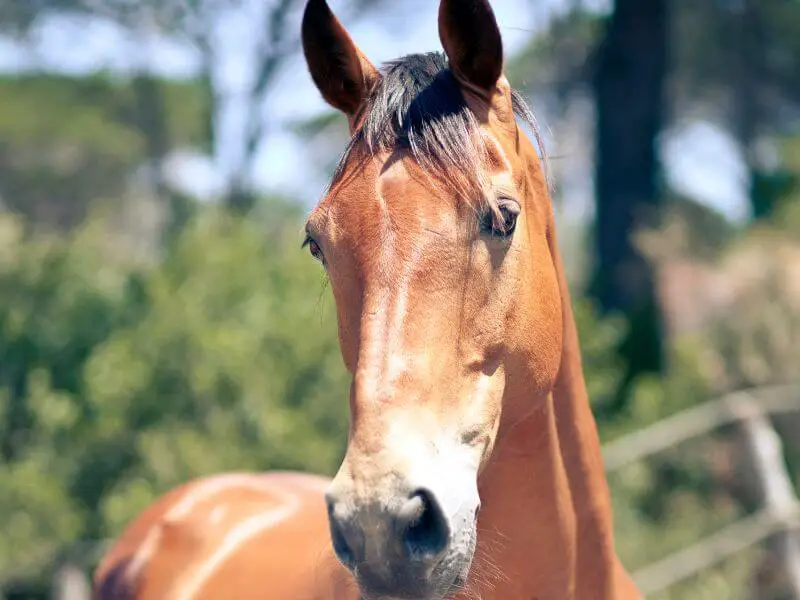
ESTABLISHING CONTROL WITH BODY LANGUAGE
When working with nervous horses, it is critical to establish control through body language, and not through force.
A confident and authoritative, yet non-threatening, body language can have a significant impact on your contact with the horse, assisting you in developing a sense of safety and trust.
Staying Confident When Approaching
When approaching a nervous horse, it’s essential to exude confidence without appearing intimidating or aggressive.
Personally I know how adopting a confident, yet non-threatening body language can make the horse feel more at ease. While if you show nervous behavior the horse may lose trust in you.
Remember walking directly towards the horse, though it may seem confident, it is actually more aggressive than if you approach them slightly sideways, as this is seen as more neutral and less threatening to the horse.
Keep your shoulders relaxed, chin up, and maintain a steady walk, but back off if they seem like they want to flee.
For example, during my experience with my first Thoroughbred mare, I found that walking slightly sideways, maintaining a neutral posture, and keeping a relaxed demeanor helped calm her nerves and establish trust.
As you approach, remember to breathe deeply and exhale slowly, which can help you stay relaxed and focused. If you are holding your breath remember to try talking in a low calm drawn out voice.
Talking keeps you from holding your breath.
Standing tall and confident is important, but it’s also essential to make sure you don’t appear too big or threatening to the horse.
Bending forward or leaning forward while going towards a horse is like another horse trying to drive the horse away. They lower their head and pin their ears.
Or it could also be taken like a predator stalking their prey.
With an anxious horse, focus on the positives and think less about fears and nerves. Building confidence when handling a nervous horse is important, and imagining yourself as confident and in control can help.
Remember that horses are incredibly responsive to human emotions and body language, so projecting confidence without appearing threatening can help the horse feel more at ease.
Using Assertive But Not Aggressive Body Language
At times, horses might feel threatened or defensive in unfamiliar situations, making it essential for a handler to be assertive without crossing the line into aggression.
Being assertive means communicating clearly that you’re in charge without resorting to violence or intimidation.
In my experience, when approaching a horse avoiding direct eye contact and walking sideways can help you establish control without making the horse feel threatened.
It’s important to avoid crossing your arms, as this defensive posture can be perceived as threatening by horses.
Instead of yelling at the horse or using forceful movements, use clear non-verbal signals like stepping backwards if the horse tries backing away from you, or stepping towards them with purpose shoulders square if you want to drive them away.
If a nervous horse is nibbling on your clothes, you can firmly say “no” and gently push its head away. This shows the horse that the behavior is not acceptable without resorting to aggression.
Being assertive but not aggressive with a nervous horse involves being calm, confident, and setting clear boundaries.
Remember, assertiveness means setting clear boundaries and saying no to unwanted behavior, but it doesn’t mean being aggressive or violent.
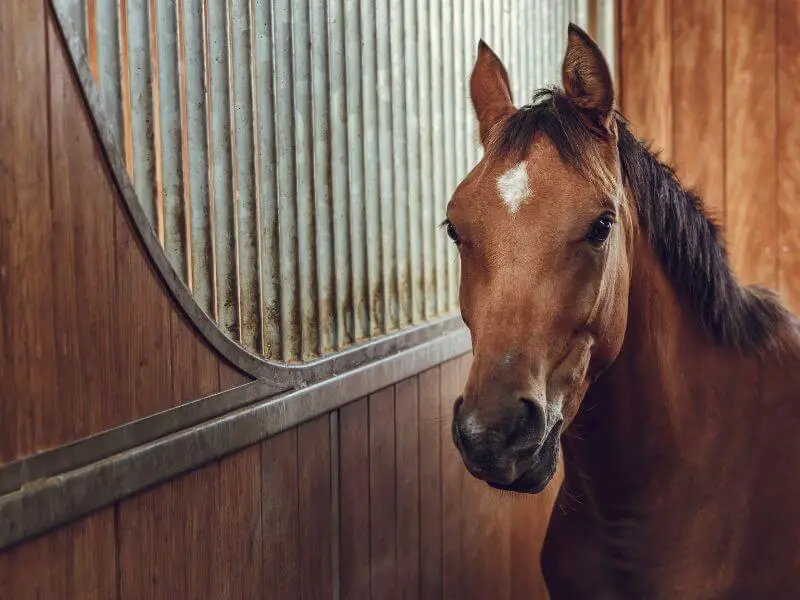
BUILDING CONFIDENCE THROUGH REPETITION
Practicing Approaching And Interacting With Nervous Horses Regularly
When it comes to approaching a nervous horse, repetition is key.
By practicing approaching and interacting with nervous horses regularly, you’ll learn to read body language more effectively and come up with strategies for calming them down.
It’s important to remember that each horse is unique, and what works for one may not work for another. Some horses may be more comfortable being approached from one side than the other, while others may prefer a particular tone of voice.
It’s essential to pay close attention to how each horse reacts and adjust your approach accordingly.
Additionally, it’s important to practice interacting with these horses in different settings or environments.
Start by interacting with the horses in their stalls or enclosures before moving onto larger spaces like arenas or pastures.
This gradual increase in exposure to new stimuli will help them feel more comfortable in various situations, making it easier for you to approach and handle them.
Gradually Increasing Exposure To New Stimuli
Once you feel confident in your ability to approach nervous horses in familiar environments, it’s time to gradually expose them to new stimuli. Taking your time and being gentle but confident can help the horse adjust to new experiences without feeling overwhelmed.
For example, you could slowly introduce unfamiliar objects, such as umbrellas or plastic bags, or acclimate them gradually to noises like cars passing by.
It’s essential that these introductions are done carefully, allowing the horse the time and space they need to adjust without overstimulating them further.
Start small with just one unfamiliar object at a time before gradually adding more. It can also be helpful if you have an experienced partner who can assist you during this process – someone who can keep an eye on the horse while you introduce new stimuli at a safe distance until they become more comfortable.
With repeated exposure, horses become accustomed to their surroundings and cease to avoid non-threatening stimuli.
Classical conditioning can also be used to reduce a horse’s fear of a stimulus through repeated pleasurable experiences in the vicinity of that stimulus.
When exposing a horse to new stimuli, it’s important to pay attention and anticipate the horse’s reaction, and to remain calm and speak to the horse quietly if it becomes frightened.
By gradually increasing exposure to new stimuli, you can help the horse become more comfortable and reduce its anxiety over time.
As always when working with animals, safety should be your top priority. If at any point you feel unsafe or unsure, it’s best to stop the interaction and seek guidance from an experienced handler.
Remember, patience and understanding are key when helping a nervous horse adapt to new situations, and by following these tips, you can help them build confidence and trust in you as their handler.
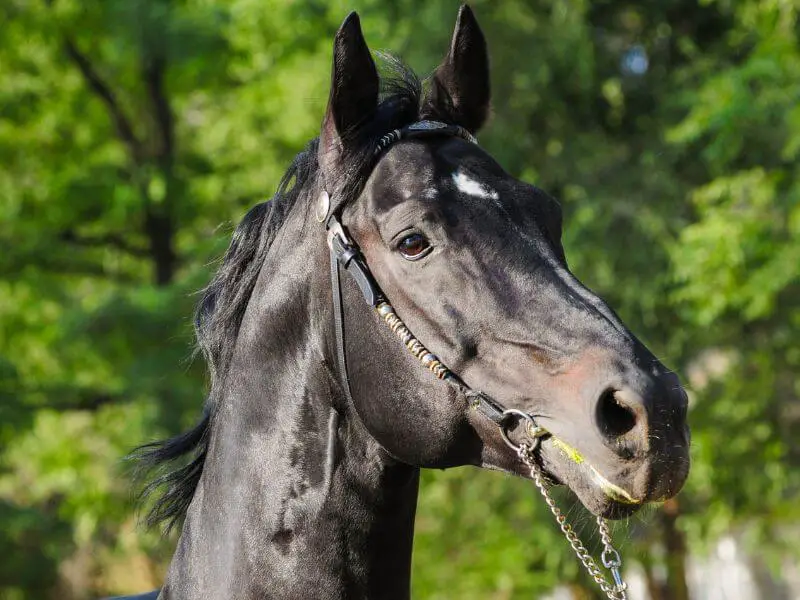
Wrapping UP APPROACHING A NERVOUS HORSE
Approaching and working with nervous horses can be a challenging but rewarding experience.
I’ve learned many times over of the importance of patience, understanding, and confidence when interacting with these sensitive animals.
By staying calm, paying attention to their body language, and taking the time to build trust, you can create a strong and lasting bond with your equine companion.
It’s essential to remember that every horse is unique, and what works for one may not work for another. Be patient and willing to adapt your approach as needed.
Gradually exposing your horse to new stimuli and environments will help them gain confidence and overcome their anxiety over time.
Lastly, never hesitate to seek guidance from experienced handlers or trainers if you’re unsure or feel unsafe during any interaction.
Equine safety and well-being should always be your top priority. By staying committed to the process and continually learning and growing as a handler, you’ll not only help your horse feel more comfortable and confident, but you’ll also become a more skilled and empathetic equestrian.
Now, it’s time to put these insights into practice and make a positive difference in the lives of the nervous horses you encounter.
| Key Takeaways For Approaching a Nervous Horse |
|---|
| 1. Stay calm and confident when approaching a nervous horse, as they can sense your emotions and energy. |
| 2. Observe the horse’s body language and identify potential triggers for nervous behavior to assess the situation. |
| 3. Create a calm environment by approaching slowly, speaking soothingly, and avoiding sudden movements or loud noises. |
| 4. Gain trust through touch by offering your hand for the horse to smell and petting gently on their neck or shoulder. |
| 5. Establish control with body language by standing tall, using assertive but not aggressive movements, and maintaining eye contact with the horse. |
| 6. Build confidence through repetition by regularly practicing approaching and interacting with nervous horses and gradually increasing exposure to new stimuli. |
| 7. Ensure safety is always the top priority when working with horses, and seek guidance from experienced handlers when necessary. |
| 8. Be patient and adaptable with each horse, understanding that every horse is unique and may require different approaches. |
| 9. Utilize classical conditioning and gradual exposure to help reduce a horse’s fear and anxiety over time. |
| 10. Remember the importance of patience, understanding, and continuous learning as a handler to create a strong and lasting bond with your equine companion. |
With these tips, you should now feel more confident and prepared to approach a nervous horse calmly and safely.
Cheers, Kacey
P.S. Did you like this article? Gallop over to:

